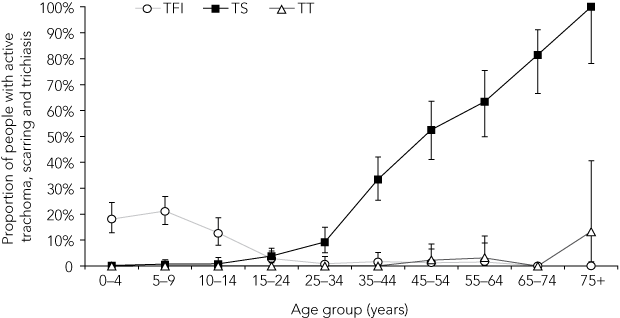To the Editor: Trachoma, caused by the bacterium Chlamydia trachomatis, is the leading cause of infectious blindness worldwide.1 In Australia, the burden of disease falls almost exclusively on the Aboriginal population.2 However, there has been little consistent data collection on the prevalence of trachoma in recent years in Australia.3,4 Furthermore, despite Australian Government recommendations for biennial screening of people aged 40–54 years and annual screening of people aged ≥ 55 years in areas where trachoma is or has been endemic,5 very little screening of older people for trachomatous trichiasis has been conducted.2,4
A representative sampling frame of those believed to be currently living in each community was constructed using the medical clinic patient list, the council housing list and the local knowledge of Aboriginal Health Workers seconded from the clinics to assist with the project. All people in each community were invited to undergo a clinical eye examination for trachoma. The parameters of the World Health Organization simplified grading scheme6 were used to determine prevalence of the five signs of trachoma: tarsal conjunctival follicles, intense inflammation, tarsal scarring, trichiasis and corneal opacity.
A total of 1316 people (85.2% of the total estimated population), including 415 children aged under 10 years, were screened for trachoma. Across the five communities, active trachoma (assessed as the presence of either follicles or inflammation in one or both eyes) was at an endemic level (> 10%). The prevalences of active trachoma, scarring and trichiasis in different age groups are summarised in the Box. The overall rate of active trachoma in children under 10 years of age was 19.8% (95% CI, 16.0%–23.9%) (n = 82), and two communities had hyperendemic prevalence of trachoma (> 20%) in this age group. The youngest child observed with active trachoma was just over 1 year old.
That trachoma is still hyperendemic in Aboriginal communities more than 30 years after the National Trachoma and Eye Health Program first identified the extent of trachoma is unconscionable. Urgent and sustained public health and clinical interventions are required, with greater commitment from politicians and health policymakers, if Australia is to join the ranks of other developed nations in eradicating endemic trachoma. The guidelines for trachoma control developed by the Communicable Diseases Network Australia5 need to be resourced appropriately and implemented.
- 1. Resnikoff S, Pascolini D, Etya’ale D, et al. Global data on visual impairment in the year 2002. Bull World Health Organ 2004; 82: 844-851.
- 2. Taylor HR. Eye health in Aboriginal and Torres Strait Islander communities. Report of a review commissioned by the Commonwealth Minister for Health and Family Services, the Hon Dr Michael Wooldridge. Canberra: Commonwealth of Australia, 1997.
- 3. Mak DB, O’Neill LM, Herceg A, McFarlane H. Prevalence and control of trachoma in Australia, 1997–2004. Commun Dis Intell 2006; 30: 236-247.
- 4. Tellis B, Keeffe JE, Taylor HR. Surveillance report for active trachoma, 2006: National Trachoma Surveillance and Reporting Unit. Commun Dis Intell 2007; 31: 366-374.
- 5. Communicable Diseases Network Australia. Guidelines for the public health management of trachoma in Australia. Canberra: Australian Department of Health and Ageing, 2006. http://www.health.gov.au/internet/main/publishing.nsf/Content/cda-cdna-pubs-trachoma.htm (accessed Jan 2008).
- 6. Thylefors B, Dawson CR, Jones BR, et al. A simple system for the assessment of trachoma and its complications. Bull World Health Organ 1987; 65: 477-483.






We wish to acknowledge the funding and assistance provided by the Fred Hollows Foundation, in particular Alison Edwards, Nick Di Candilo and Bino Toby. We thank the health clinic staff in each community, in particular the Aboriginal Health Workers, and also the Katherine region health services, without whose cooperation this project would not have been possible: Sunrise Health Service, Wurli Wurlijang and Katherine West Health Board. We are grateful for the help of our field assistants Cath Kelaher, Bianca Webb-Pullman, Tomer Shemesh, Anu Mathew, Janet Taylor and Robyn Lilienthal. Katrina Roper conducted this study as part of her scholarship in the Master of Applied Epidemiology (MAE) degree at the Australian National University. The MAE program is funded by the Australian Government Department of Health and Ageing. Paul Kelly’s salary is partly supported by the National Health and Medical Research Council.